Diving with Wrasse
Lanta Marine Life | Labridae
Brothers and sisters to the parrotfishes, wrasse are a large and very diverse group of fish, commonly seen on all Koh Lanta diving trips. Many species have thick lips, long, slender bodies, a pointed snout and are often brightly coloured.
Many species have outward jutting teeth, usually with gaps between them and may also have jaws which can be extended to aid feeding (protrusible). Wrasse are efficient carnivores, feeding on a wide range of small invertebrates. Many smaller wrasses follow the feeding trails of larger fish, picking up invertebrates disturbed by their passing. Some small species remove parasites of larger fishes and are well known for cleaning stations.
Most species of wrasse change colour and sex as they grow. As juveniles in the initial phase, they can be either male or female, however as they grow into the terminal phase (last phase) then become brightly coloured territorial males. These males will then dominate a harem of several younger females. Most species have at least two sex-related colour forms.
26 species found on this page:
- Floral Wrasse (Cheilinus chlorourus)
- Redbreasted Wrasse (Cheilinus fasciatus)
- Tripletail Wrasse (Cheilinus trilobatus)
- Linedcheek Wrasse (Oxycheilinus digramma)
- Blackeye Thicklip Wrasse (Hemigymnus melapterus)
- Barred Thicklip Wrasse (Hemigymnus fasciatus)
- Moon Wrasse (Thalassoma lunare)
- Peacock Razor Wrasse (Iniistius pavo)
- Rock Mover Wrasse (Novaculichthys taeniourus)
- Slingjaw Wrasse (Epibulus insidiator)
- Zigzag Wrasse (Halichoeres scapularis)
- Dusky Wrasse (Halichoeres marginatus)
- Pastel-Green Wrasse (Halichoeres chloropterus)
- Canarytop Wrasse (Halichoeres leucoxanthus)
- Checkerboard Wrasse (Halichoeres hortulanus)
- Indian Bird Wrasse (Gomphosus caeruleus)
- Blue-spotted Wrasse (Anampses caeruleopunctatus)
- Lined Wrasse (Anampses lineatus)
- Bluestreak Cleaner Wrasse (Labroides dimidiatus)
- Bicolour Cleaner Wrasse (Labroides bicolor)
- Three-lined Rainbowfish (Stethojulis trilineata)
- Neill's Hogfish (Bodianus neilli)
- Blackbelt Hogfish (Bodianus mesothorax)
- Redfin Hogfish (Bodianus dictynna)
- Batu Coris (Coris batuerisis)
- Chiseltooth Wrasse (Pseudodax moluccanus)
Floral Wrasse
(Cheilinus chlorourus)
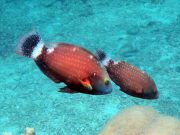
Cheilinus chlorourus @ Koh Bida
The Floral Wrasse has a variable body colour, ranging from orange-brown to green-brown. There are usually horizontal rows of pink or white spots along the body and often white to whitish blotches on the back and tail, including a whitish vertical bar on the tail base. The pelvic, anal and tail fins have numerous black and white specks.
The Floral Wrasse grows to 36 cm and is usually solitary, only forming pairs when breeding. This species is usually observed over sand and rubble areas at the reef edge. The diet includes bottom-dwelling invertebrates such as mollusks and crustaceans.
Redbreasted Wrasse
(Cheilinus fasciatus)
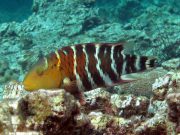
Cheilinus fasciatus @ Koh Bida
The Redbreasted Wrasse has a pattern of 6 - 7 alternating white and brownish-black bars on the body and tail. There is a wide red-orange bar behind the bead which may extend onto some or all of the head, otherwise the head may have significant green colouration, particularly the forehead. Several red lines radiate from the eye. May have reddish-brown colouration on the dorsal, pectoral, pelvic and anal fins.
The Redbreasted Wrasse grows to 36 cm and is solitary. The diet includes bottom-swelling, hard-shelled invertebrates, including mollusks, crustaceans and sea urchins, and this species can be found near sandy or rubble areas at the reef edge.
Tripletail Wrasse
(Cheilinus trilobatus)
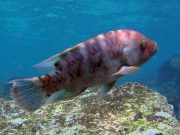
Cheilinus trilobatus @ Koh Bida
The Tripletail Wrasse, or Tripletail Maori Wrasse, has a variable body colour and is capable of rapid colour change.
The body colour ranges from green to brown, with mottled purple and red markings and four vertical dark bars. The head has many small red spots, with red lines radiating from the eye.
The tail fin is rounded and may have protruding upper and lower fin lobes. The fins are yellow or green with red and brown streaks and marks.
The Tripletail Wrasse grows to 45 cm, but more usually observed 20 cm - 30 cm.
This is a solitary species and the diet includes snails, crustaceans, and occasionally fish.
Linedcheek Wrasse
(Oxycheilinus digramma)

Oxycheilinus digramma @ Koh Haa
The Linedcheek Wrasse has a variable body colour and markings. The body is usually shades of green, brown, and red, with wide bar markings on the back and a small dark bar marking on each scale. The cheek and lower head has many diagonal lines, from the edge of the mouth to the pectoral fins.
Some other body colour variations exist, however all variations have the diagonal lines on the cheek and lower head.
The Linedcheek Wrasse grows to 30 cm, but more often observed 15 cm - 20 cm. The diet includes snails, crustaceans, and sea urchins. This species will closely approach divers and is solitary.
Blackeye Thicklip Wrasse
(Hemigymnus melapterus)
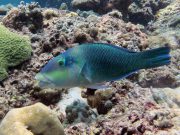
Hemigymnus melapterus @ Koh Bida
The Blackeye Thicklip Wrasse colour varies with age. Adults have a lighter head and forebody, mostly whitish to greenish or greyish.
There is a diagonal line between the front of the dorsal fin and the front of the anal fin, sometimes not very prominent. The rear of the body is blackish to dark green. The scales have a dark outline and lighter center. There may be a pattern of scribbles and lines on the head.
There is often a large dusky spot behind the eye. Juveniles often with a yellow tail. The lips are very thick.
The Blackeye Thicklip Wrasse grows to 60 cm but more often observed around 25 cm - 35 cm. This species is usually seen alone, close to the sand and rubble areas at the reef edge and feeds mainly on small invertebrates, especially crustaceans, bristle-worms, mollusks and brittle stars.
Barred Thicklip Wrasse
(Hemigymnus fasciatus)
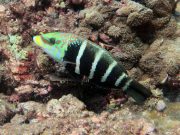
Adult Hemigymnus fasciatus @ Koh Bida
The adult Barred Thicklip Wrasse has a black body with 5 narrow white bars. The head is green with pink , orange and green bands, and the upper lip and snout area may have a yellow bar. The lips are very thick. The white bars toward the rear of the body fade with age.
Juveniles have a light green head and dark green to brownish body with 5 or 6 narrow pale or white bars. Juveniles display this colouring to around 6 cm and can be found among the branches of Acropora corals.
The adult Barred Thicklip Wrasse grows to 50 cm, though more often observed in the 20 cm to 30 cm range. This species is generally seen at the outer reef edges near sand and coral rubble and feeds on small crustaceans, mollusks and echinoderms such as sea urchins.
Moon Wrasse
(Thalassoma lunare)
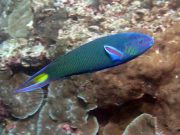
Thalassoma lunare @ Koh Haa
The Moon Wrasse, or Crescent Wrasse has a blue-green to blue body with light purple and green bands on the head. The pectoral fins have a purple center and blue margin. The tail is deeply forked, with blue-edged purple lobes and a yellow center.
The Moon Wrasse grows to 25 cm, but usually observed around 10 cm - 15 cm. This species is often solitary, but may form small, loose groups. The diet includes bottom-dwelling invertebrates and fish eggs.
Peacock Razor Wrasse
(Iniistius pavo)
The adult Peacock Razor Wrasse has a light grey body with a whitish patch on the lower body with one or two darker spots above, and may have some dusky bars. The first dorsal spine is long and can be raised and projected forward. The head is steep and blunt.
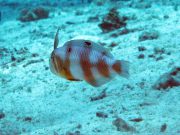
Sub Adult Iniistius pavo @ Koh Haa
Juvenile Peacock Razor Wrasse has many different colour variations, including a whitish body with multiple dark bars, a dark patch on the upper forebody and one or more other dark patches on the dorsal fin.
The adult Peacock Razor Wrasse grows to 35 cm. This species dives into the sand when alarmed. Juveniles are found over sandy and rubble areas to 20 m where they mimic drifting leaves and debris. Adults are usually found in deeper water, 20+ m and feed on hard-shelled invertebrates, including mollusks and crustaceans.
Rock Mover Wrasse
(Novaculichthys taeniourus)

Juvenile Novaculichthys taeniourus @ Koh Haa
The Rock Mover Wrasse has a pale grey head, a dark brown to black body with a pale spot on each scale. There is a white bar on the tail base and there may be lines radiating from the eye.
Juvenile Rock Mover Wrasse up to 8 cm have 'antlers' at the front of the dorsal fin and a green to brown to maroon body. The body has several irregular white spots and three black bars, and the head also has several white bands. Juveniles 'wiggle' to mimic drifting weed and leaves as a form of camouflage protection.
Adult Rock Mover Wrasse grow to 27 cm, but usually observed smaller than this. Adults of this species turn over rocks and rubble in search of prey with their mouths and snouts. This species can be found on coral rubble bottoms close to the reef edge.
Slingjaw Wrasse
(Epibulus insidiator)

Epibulus insidiator @ Koh Bida
As a juvenile in the Initial Phase (IP), the Slingjaw Wrasse is coloured either bright yellow with yellow fins, or shades of pale or dark brown with a black outline to the scales.
As the Slingjaw Wrasse enters the Terminal Phase (TP) and changes sex to a male, the body colour changes. The body becomes dark, with an orange back from the head to the mid-body. The head is partially, or completely whitish, and there is a dark outline on the large scales. There may be a black streak through the eye in older individuals.
The mouth of this species can be extended, swinging forward into a long tube about half the body length. The jaws are expanded to create strong suction which quickly draws prey into the mouth. When not in use, the entire apparatus is folded under the head.
The Slingjaw Wrasse grows to 35 cm and the diet includes small coral-dwelling crustaceans and fish.
Zigzag Wrasse
(Halichoeres scapularis)

Halichoeres scapularis @ Koh Haa
Adult (male) Zigzag Wrasse have a whitish body with pale blue and pinkish zig zag stripes along the body, and stronger/darker similar coloured bars and marks on the head.
Adults may also have a yellowish area under the chin and on the rear dorsal fin. The tail fin is light coloured, with wavy vertical pink lines and a yellow margin. There may be some dusky dark areas along the sides, remnants of the juvenile colouration.
Juveniles (females) have a very dark, thick, zig-zag stripe from the eye to the tail fin. Over time, this zig zag pattern thins and fades to pinkish to lavender and light blue.
Adult Zigzag Wrasse grow to 20 cm, but more usually observed around 15 cm. This species is usually seen over sand and rubble areas close to the reef edge. Feeds on small crustaceans found on the sand and rubble bottom.
Dusky Wrasse
(Halichoeres marginatus)
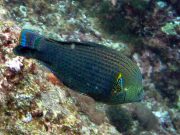
Halichoeres marginatus @ Koh Haa
The male Dusky Wrasse has a greenish to brownish body with narrow blue bands on the head. The body has around 15 stripes comprised of many connected dark blue spots.
The dorsal and anal fins have blue margins, and the pectoral and tail fins have yellow margins with a blue inner band. The tail fin has several bands, with a yellow margin, light blue sub margin, followed by a darker blue band with light spots and a greenish yellow crescent-shaped band on the tail base.
Females have a more brownish body, with darker narrow stripes along the side and a black ocellus (eye-like spot) on the middle of the dorsal fin.
The Dusky Wrasse grows to 17 cm, more often observed in the 10 cm - 12 cm range and is seen over sandy bottoms next to coral rich areas.
Pastel-Green Wrasse
(Halichoeres chloropterus)

Halichoeres chloropterus (IP) @ Hin Bida
The adult male (Terminal Phase, TP) Pastel-Green Wrasse has a pastel green body with lavender spots on the scales. There may be a small yellow patch behind the eye, and there are lavender markings on the head.
The Initial Phase (IP) Pastel-Green Wrasse is yellow to green, usually with white lower head and forebody. May have rows of small black spots on the mid to rear body which appear in the Juvenile Phase. Initial Phase specimens may also have a large dark oval blotch on the side..
Juvenile Pastel-Green Wrasses are white with three to four brown or dark greenish horizontal stripes and possibly several horizontal rows of small black spots which may continue into the Initial Phase (IP).
The Pastel-Green Wrasse is generally seen solitary and can be found on coral reef edges close to sand and rubble bottoms.
Canarytop Wrasse
(Halichoeres leucoxanthus)
The adult male (TP) Canarytop Wrasse has a bright golden yellow upper body and a white lower body.

Halichoeres leucoxanthus @ Koh Haa
The Initial Phase (younger male and female adult) Canarytop Wrasse are similar to the Terminal Phase but with 3 black spots on the dorsal fin.
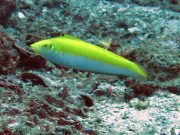
Canarytop Wrasse @ Koh Haa
The Canarytop Wrasse grows to 11 cm, but more often observed around 4 cm - 8 cm and found over sand and rubble ares close to coral rich areas.
Checkerboard Wrasse
(Halichoeres hortulanus)
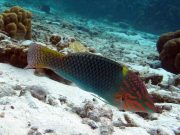
Halichoeres hortulanus (TP) @ Koh Haa
The Adult/Terminal Phase (TP) male Checkerboard Wrasse is generally green with a blue band on each scale.
There are green and pinkish orange bands on the head. There is a slightly paler green area behind the head, with a yellow spot above, at the start of the dorsal fin.
The Initial Phase (IP) females have a paler body, with several yellow saddles on the back, and a dark spot at the base of the dorsal fin. The tail colour varies from bluish to reddish to yellowish.
The Checkerboard Wrasse grows to 27 cm but more often observed below 20 cm.
The diet includes small invertebrates such as crustaceans, molluscs, worms, and echinoderms found in the sand.
Indian Bird Wrasse
(Gomphosus caeruleus)
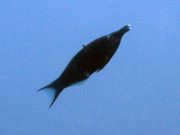
Gomphosus caeruleus @ Koh Haa
The adult (male) Indian Bird Wrasse, or Green Birdmouth Wrasse has a slender body and greatly elongated snout. The head and body are dark blue to dark green. Distinguished from the Bird Wrasse (Gomphosus varius) by location - the Indian Bird Wrasse is native to the Andaman Sea.
Juvenile (female) Indian Bird Wrasse have a dark upper body, white on the lower head, and a yellowish to copperish lower body, anal and tail fins.
Adult Indian Bird Wrassecan grow to 32 cm, but more usually observed around 20 cm. The diet includes small invertebrates, and this species can be found on both coral rich and rocky reef areas.
Blue-spotted Wrasse
(Anampses caeruleopunctatus)
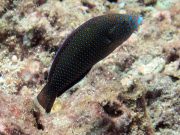
Juvenile Anampses caeruleopunctatus @ Koh Haa
The Blue Spotted Wrasse, or Diamond Wrasse body varies with age. The Juvenile Phase (JP) body is green to brownish green with horizontal rows of blue spots on the side and head and blue margins on the fins.
As the fish grows, the Intermediate Phase (IP) body is similar to the juvenile, however the bright blue face and head spots start to merge into lines and bands.
In the Adult Phase, or Terminal Phase (TP), the sex changes to male and instead of bright blue spots on the body, each scale now has a blue-green vertical streak and there is now a yellowish or lime-green bar on the body, behind the pectoral fins. The Terminal Phase body is generally a darker bluish-green.
The Blue Spotted Wrasse grows to 42 cm, but usually observed much smaller. The diet includes crustaceans, mollusks and bristle-worms.
Tiny juveniles may swim with the head towards the bottom and slowly rock their body from side to side as they swim, looking like a floating leaf in the current.
Lined Wrasse
(Anampses lineatus)

Anampses lineatus @ Koh Haa
The Lined Wrasse has a black to brownish body with while horizontal lines or spots on the side.
The Terminal Phase (TP) male has a black tail with a white bar across the base. Intermediate Phase (IP) males or females have a red tail with a white bar.
The Lined Wrasse grows to 12 and may bury in sand at night for protection.
Bluestreak Cleaner Wrasse
(Labroides dimidiatus)

Labroides dimidiatus @ Koh Bida
The Bluestreak Cleaner Wrasse has a whitish to yellowish head, with the body colour becoming more blue toward the tail. A stripe from the snout becomes progressively wider toward the tail.
The Bluestreak Cleaner Wrasse grows to 12 cm, but usually observed in the 5 cm - 7 cm range.
This species can be seen solitary or forming pairs to establish cleaning stations, swimming with a distinct jerky motion to attract other fish. The purpose of cleaning stations is to remove parasites and dead tissue from larger fish.
Cleaning stations may also be occupied by a group of juveniles or a group of females accompanied by a dominant male. In this case, a female will change sex to male if the dominant male is lost.
Bicolour Cleaner Wrasse
(Labroides bicolor)
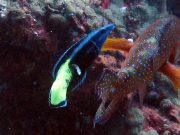
Labroides bicolor @ Hin Daeng
The Bicolour Cleaner Wrasse is an elongated wrasse with a pointed snout. The adult forebody is dark, often black and blue. The rear body is a lighter white or yellowish colour.
As the adult matures, the tail turns a stronger yellow, with the yellow colour gradually extending along the body with age. The tail has a black margin. Older specimens can be up to one half yellow.
Juveniles have a white or pale yellow body, with a black stripe running from the snout through the eye to around two thirds of the way along the body.
The Bicolour Cleaner Wrasse grows to 15 cm, but more often observed around 10 cm. This species has a persistent energetic behaviour and is territorial around it's cleaning station.
The Bicolour Cleaner Wrasse is only occasionally seen at the dive sites around Koh Lanta.
Feeds on parasites, mucus and other detritus removed from it's cleaning clients.
Three-lined Rainbowfish
(Stethojulis trilineata)

Stethojulis trilineata @ Koh Haa
The Three-lined Rainbowfish has a greenish body and red dorsal fin. There is a yellow-orangish patch around pectoral fin and occasionally on the back.
Terminal phase males have 4 bright blue stripes, three from head to tail and one from above the snout to above the pectoral fin.
The Three-lined Rainbowfish grows to 14 cm and is uncommon at the dive sites around Koh Lanta. Sometimes called the Four-lined Wrasse, or the Blue-ribbon Wrasse.
Neill's Hogfish
(Bodianus neilli)

Bodianus neilli @ Koh Haa
Neill's Hogfish has a reddish brown head and upper forebody. The lower and rear body are white and there is a dark red or blackish blotch on the middle of the dorsal and anal fins.
The pectoral fins have a red streak at the base, and the tail fin has a light reddish tinge to it.
Neill's Hogfish grows to 20 cm and is found mainly in the Andaman Sea to Sri Lanka and Maldives coast.
Blackbelt Hogfish
(Bodianus mesothorax)
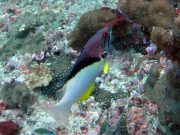
Bodianus mesothorax @ Koh Haa
The Blackbelt Hogfish has a purplish-brown head and forebody, with rows of dark spots on the forebody, followed by a thick dark band on the forebody, starting just above the pectoral fins to the dorsal fin.
There is a thick, dark spot at the pectoral fin base. The mid and rear body are white, sometimes with yellow areas. The ventral and anal fins are yellow.
Juvenile Blackbelt Hogfish have a purple to almost black body with two rows of large yellow spots with black margins, usually sheltering under ledges and in protected areas.
The Blackbelt Hogfish grows to 19 cm, though more often observed around 10 cm - 12 cm.
Redfin Hogfish
(Bodianus dictynna)

Bodianus dictynna @ Koh Haa
The Redfin Hogfish has a dark brownish to dark reddish head and back, with lighter, yellowish sides and several white spots on the upper back.
The ventral fin, anal fin and rear dorsal fin are partially translucent with dark margins. There is a dark spot in the middle of the tail fin.
Redfin Hogfish grows to 14 cm and feeds mainly on bottom dwelling invertebrates such as molluscs and crustaceans.
Juveniles are known to remove parasites from other fishes, similar to cleaner wrasse.
Batu Coris
(Coris batuerisis)

Coris batuerisis @ Koh Haa
The Batu Coris has a whitish to pale green body with several dark bars and narrow white bars alternating along the upper body.
There is a dark spot with a pale border around the middle of the dorsal fin.
The Batu Coris grows to 17 cm but usually observed 5 cm - 12 cm, and is often seen over sand and rubble areas close to coral rich reefs.
Chiseltooth Wrasse
(Pseudodax moluccanus)

Pseudodax moluccanus @ Koh Haa
The Chiseltooth Wrasse has a blue-green body colour with dark spots on the scales. There is an orange-red rusty wash on the forward body and the back. The upper lip is yellow with a blue streak above it, and there is a yellow bar on the tail base.
Juvenile Chiseltooth Wrasse resemble and sometimes behave like cleaner wrasse, removing external parasites from other fishes.
Due to the pattern of teeth, the Chiseltooth Wrasse is regarded as being very closely related to Parrotfishes, however it's behavior is more like those wrasse of the genus Anampses, such as the Lined Wrasse, or the Blue-spotted Wrasse.
The Chiseltooth Wrasse grows to 30 cm. Adults are usually solitary and feed on small invertebrates and algae.
Diving with Wrasse around Koh Lanta
Scuba Diving & Snorkel Trips
If you'd love a chance to spot Wrasse on one of our daily high season diving trips from Koh Lanta then send us an email to info@diveandrelax.com.
Join our high season speedboat dive trips to some of Thailand's best dive sites and enjoy small groups, short journey times, with a focus on great personal service, safety and fun.
Not yet a certified diver? Learn to Scuba Dive on Koh Lanta with the 3 day SSI Open Water Diver course.
Book online to save 10% on dive trips and scuba courses on Koh Lanta.
Find Out More
Indo-Pacific Marine Life Guides
- Allen, G., Steene, R., Humann, P., DeLoach, N. (2003) Reef Fish Identification, Tropical Pacific. Jacksonville, FL., USA: New World Publications, Inc., ISBN 1-878348-36-1.
- Humann, P., DeLoach, N., (2010) Reef Creature Identification, Tropical Pacific. Jacksonville, FL., USA: New World Publications Inc., ISBN 978-1-878348-44-9
- Debelius, H. (2013) Indian Ocean Reef Guide. Frankfurt, Germany: IKAN - Unterwasserarchiv, ISBN 978-3-939767-52-7.
- Debelius, H. (2004) Nudibranchs and Sea Snails, Indo-Pacific Field Guide. Frankfurt, Germany: IKAN - Unterwasserarchiv, ISBN 3-925919-51-1
- Erhardt, H., Knop, D. (2015) Corals Indo-Pacific Field Guide. Frankfurt, Germany: IKAN - Unterwasserarchiv, ISBN 3-925919-69-4.
- Veron J.E.N., Stafford-Smith M.G., Turak E. and DeVantier L.M. (2016). Corals of the World


